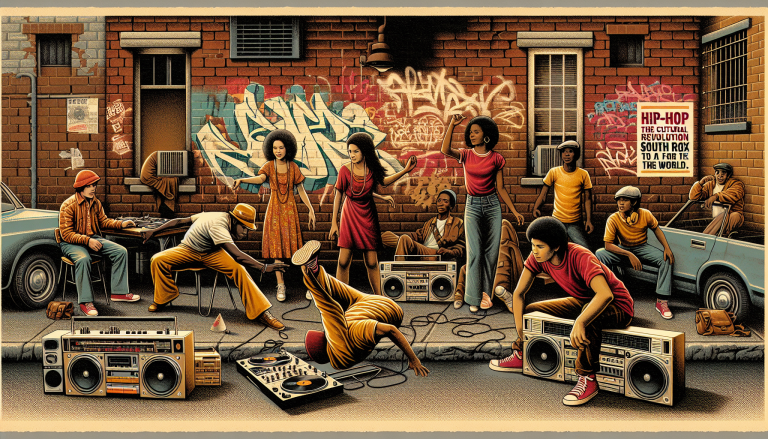Birth of a Cultural Juggernaut: The Historical Context of Hip-Hop
Picture this: It’s the South Bronx, New York City, early 1970s. Urban decay, economic hardship, and a vibrant, tight-knit community mixing creativity with survival instincts. In this crucible of adversity and expression, hip-hop emerged—not just as a music genre, but as a cultural revolution. It was born from the tireless hands and inventive minds of DJs spinning vinyl at block parties, transforming simple gatherings into energetic celebrations of urban life. Hip-hop was more than sound; it was a potent form of storytelling and social commentary that found voice among marginalized voices and laid the foundation for one of the most influential movements in American music history.
Hip-hop’s roots can be traced to pioneering block party DJs like Kool Herc, Afrika Bambaataa, and Grandmaster Flash. These visionaries didn’t just play music—they invented techniques like break-beat looping and scratching that redefined what sound could do. From these mechanical marvels, MCs began rhyming over beats, giving birth to rap—the lyrical backbone of hip-hop. It was raw, rhythmic poetry that reflected everyday struggles, ambitions, and the pulse of city streets. This was a seismic shift in music: art created not with grand orchestras but with turntables, microphones, and the narratives of ordinary people rising above the noise.
What Exactly Is Hip-Hop? An Eclectic Symphony of Sound and Soul
Calling hip-hop just a music genre is like calling the Grand Canyon a ditch—it barely scratches the surface. Hip-hop is an entire culture and artistic ecosystem that encompasses four key elements: MCing (rapping), DJing, breakdancing (b-boying), and graffiti art. At its sonic core, hip-hop is built on rhythm and rhyme, underpinned by beat-driven production that pulls from funk, soul, jazz, and later, electronic influences.

The beauty of hip-hop lies in its adaptability and endless reinvention. It’s a playground for lyricism, where wordplay, storytelling, social critique, and swagger burst from the mouth of the MC like fireworks over a city skyline. From boom bap classicism to trap’s rattling hi-hats, hip-hop’s soundscape is kaleidoscopic and ever-evolving. But at its heart, it’s the rhythm-driven pulse and defiant spirit inherited from African American communities that fuels hip-hop’s relentless energy.
Hip-Hop Titans: Key Artists Who Shaped the Genre
It’s impossible to talk hip-hop without revering the architects who built its foundation, each adding bricks with groundbreaking innovation and cultural resonance. Kool Herc, with his ingenious break-beat looping in the early 70s, was the spark that ignited the movement. Grandmaster Flash elevated DJing with precision and flair, pioneering scratching techniques that turned turntables into instruments.
Fast forward, and names like Run-D.M.C. electrify audiences with their fusion of rock and rap, breaking hip-hop into the mainstream during the ’80s. Public Enemy brought political fire, using bombastic beats and incendiary lyrics to amplify social justice messages. The ’90s heralded legends like Tupac Shakur and The Notorious B.I.G., whose storytelling mixed street sagas with emotional vulnerability, forever changing the narrative scope of American music.
On the production side, Dr. Dre’s G-funk redefined West Coast beats, dripping with funk samples and smooth synthesizers. Nas gifted hip-hop a literary lens with the timeless classic *Illmatic,* while Jay-Z’s shrewd lyricism and business acumen broadened the genre’s global reach. These artists didn’t just make records; they shaped culture, transformed style, and influenced generations.
Equally Essential Soundtracks: Notable Songs and Albums
Every music lover knows that hip-hop’s magic is best felt through the speakers—its anthems, beats, and groundbreaking albums that capture moments in time and push the genre’s boundaries. Take *The Message* by Grandmaster Flash and the Furious Five (1982): a stark, unflinching portrayal of urban hardship, it pivoted hip-hop from party music to social commentary. Then there’s *Paid in Full* by Eric B. & Rakim, a textbook on intricate rhyme schemes and immaculate flow, which expanded rap’s lyrical possibilities.
The 1990s unleashed classics like Tupac’s *All Eyez on Me* and The Notorious B.I.G.’s *Ready to Die,* albums that combine raw emotion, complex storytelling, and charismatic bravado. Meanwhile, Nas’s *Illmatic* remains a masterclass in poetic rap, offering vivid depictions of life in Queensbridge with razor-sharp lyricism.
Dr. Dre’s *The Chronic* introduced the world to the laid-back, funk-infused G-funk sound, influencing West Coast hip-hop for decades and launching careers like Snoop Dogg’s. Jay-Z’s *The Blueprint* solidified his place as rap royalty, blending soulful samples with polished lyrical prowess. These albums aren’t just collections of tracks; they’re cultural milestones that echo in clubs, radio waves, and concert arenas worldwide.
Hip-Hop’s Enduring Legacy: More Than Just Music
Hip-hop hasn’t simply survived; it has thrived, grown, and permeated global consciousness in ways few other music forms have. Its DNA is embedded in fashion, language, dance, and the ethos of rebellion and self-expression. Hip-hop challenged traditional notions of American music by providing a platform for marginalized voices and influencing countless other genres—EDM and dance music included. Think about it: today’s electronic beats often borrow hip-hop’s sampling techniques and rhythmic complexity, creating a fusion that reverberates on festival stages from Miami to Berlin.
Hip-hop’s cultural exports range from popular slang and streetwear to blockbuster films and art exhibitions. The genre’s emphasis on authenticity and innovation continues to inspire producers, DJs, and rappers bending genres and breaking molds. Moreover, hip-hop’s fearless engagement with social issues—from police brutality to racial identity—reminds us that music can be both a megaphone and a mirror reflecting society’s tensions and triumphs.
In the endless rhythm of American music, hip-hop stands as a pulsating heartbeat—an ever-flowing stream of creativity, resistance, and hope. It transformed turntables into tools of storytelling, finding harmony between the grind of daily life and the dreams that propel us forward. If the world’s musical species were a party, hip-hop is the electrifying dance floor where everyone’s invited, and the beat never drops alone. So the next time you hear that familiar scratch or spitfire rhyme, know you’re experiencing a lineage of innovation and culture that started with a scratch, a rhyme, and a dance, and continues to shape the soundtrack of our lives.